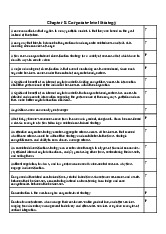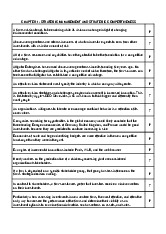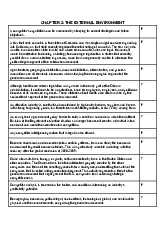






Preview text:
lOMoARcPSD| 38777299
National Economics University
BUSINESS STRATEGY AND POLICY INDIVIDUAL ASSIGNMENT
MINI CASE: UPSTART HOLDINGS
Upstart Holdings, a firm that specializes in financing driven by artificial
intelligence, is just one example of the kind of company that demands careful
consideration of many different criteria while investing in the stock market.
The factors that an investor may think about while choosing whether to
purchase, sell, or hold Upstart stock will be discussed in this essay. I. Profile of Upstart Holdings:
Upstart Holdings, Inc. is a financial technology (fintech) company that focuses
on using artificial intelligence and machine learning to facilitate and streamline
the lending process. Upstart is one of the first companies in the credit industry
to apply AI. Since its inception, the company witnessed rapid growth and in
2020, Upstart went public and began trading on the NASDAQ stock exchange. lOMoARcPSD| 38777299 II.
Value proposition of Upstart:
The value proposition of Upstart Holdings revolves around leveraging
technology, specifically artificial intelligence and machine learning, to
transform the traditional lending landscape, including using sophisticated
algorithms to assess the creditworthiness of borrowers and use of alternative
data and advanced analytics allows it to extend credit to individuals who might
be overlooked by traditional credit scoring models. III.
Upstart Holdings’s business model:
First of all, the core function of Upstart’s business model includes two aspects.
The first one is an AI-powered lending platform called Upstart's platform,
known as the Upstart Marketplace, analyzes over 1,600 data points about
potential borrowers, including traditional credit scores, employment history,
education, and alternative data like property records and purchase history. This
comprehensive analysis allows Upstart to assess creditworthiness beyond
traditional measures and predict loan behavior with greater accuracy. The other
one is risk modeling, in which Upstart's AI models create customized risk
assessments for each borrower, assigning them an "Upstart Grade" that reflects
their predicted creditworthiness. Lenders use these grades to make informed
lending decisions, potentially approving loans for borrowers who might be
rejected by traditional methods. In addition, Upstart primarily earns revenue
through transaction fees charged to partner lenders for each loan approved
through its platform. These fees are typically a percentage of the loan amount,
ranging from 2.5% to 5%. Upstart also charges additional service fees to
lenders for using its platform's functionalities. These fees can include charges
for loan servicing, document management, and data analytics. Then Upstart
sells loans originated through its platform to institutional investors like banks
and asset managers. It earns fees from investors based on the outstanding
principal of the loans. Considering its partnerships, Upstart may collaborate
with banks and other financial institutions to facilitate loans. Through these
partnerships, Upstart can leverage its technology to enhance the lending processes of its partners. IV. Industry analysis: lOMoARcPSD| 38777299
Upstart Holdings operates in the financial technology (fintech) industry,
specifically within the online lending and alternative lending sub-sectors. This
rapidly evolving landscape presents both exciting opportunities and significant
challenges for Upstart. To express this, here are the market opportunities for
Upstart. To begin with, the global demand for credit is expected to continue
growing, driven by factors such as rising household incomes, increasing
urbanization, and expanding access to financial services in developing
economies. Next, shifting consumer preferences refers to borrowers
increasingly seeking convenient and transparent online lending options, driven
by the rise of digital banking and mobile technologies. And traditional lending
practices often rely on credit scores and limited data points, potentially
overlooking creditworthy borrowers with thin credit files or alternative data
profiles. This creates an opportunity for AI-powered lending platforms like
Upstart to disrupt the market by expanding access to credit and offering more
competitive rates. To provide a competitive landscape, it is mentioned about
established banks and credit unions. These traditional players hold a significant
market share and have well-established customer bases. They are increasingly
investing in their own digital lending platforms and adopting AI-powered
solutions. What is more, other fintech lending startups are vying for market
share in online lending, offering various loan types and utilizing different
technologies, including peer-to-peer lending and blockchain. Additionally,
there are also alternative lenders, like payday lenders and other high-interest
lenders cater to borrowers with poor credit, but their practices are often
criticized for predatory lending tactics. Upstart can potentially offer these
borrowers a more affordable and responsible alternative. Therefore, we can
come with challenges and risks for Upstart. During economic downturns, loan
delinquency rates could rise, impacting Upstart's revenue and profitability.
Moreover, the evolving regulatory landscape for AI-powered lending could
pose challenges for Upstart. The company needs to ensure compliance with all
relevant regulations and build trust with regulators and consumers. Data
privacy concerns are also considered as challenges. Upstart's use of alternative
data raises concerns about data privacy and consumer protection. The company
needs to address these concerns transparently and ensure responsible data
handling practices. Lastly, Upstart's success hinges on the continued
development and refinement of its AI platform. Failure to stay at the forefront
of AI technology could leave Upstart vulnerable to competition. However,
Upstart's competitive advantages are still recognizable. Upstart's AI platform is
its core differentiator, enabling it to assess creditworthiness more accurately lOMoARcPSD| 38777299
and expand access to credit for underserved borrowers. Its partnerships are also
a key strategic advantage. Upstart's partnerships with established financial
institutions provide it with access to funding and a large customer base.
Furthermore, Upstart's emphasis on responsible lending practices and
transparent pricing helps it build trust with borrowers and regulators. V.
Value chain analysis of Upstart:
Upstart Holdings operates within a complex value chain in the online lending
industry, involving various stages and participants. In terms of upstream
activities, Upstart sources data from various sources, including traditional
credit bureaus, alternative data providers like public records and purchase
history, and its own platform usage data. This data is crucial for training and
refining its AI models. Moreover, Upstart invests heavily in research and
development, constantly improving its AI-powered lending platform. This
includes developing new algorithms, refining risk assessment models, and
integrating new data sources. Lastly, Upstart collaborates with established
financial institutions like banks and credit unions to secure funding for loans
originated through its platform. It also partners with data providers and
technology companies to enhance its data pool and platform functionalities. Its
core activities are also considerable. Upstart's AI platform analyzes potential
borrowers' data and assigns Upstart Grades, predicting their creditworthiness.
This information is then used to match borrowers with suitable lenders on the
platform and facilitate loan applications. Upstart's AI models continuously
monitor loan performance and predict potential delinquencies. This allows
lenders to make informed decisions about loan pricing and risk management
strategies. Finally, Upstart manages its online Marketplace platform,
connecting borrowers and lenders, facilitating loan origination, and handling
document management and other administrative tasks. In terms of downstream
activities, Upstart partners with lenders for loan servicing, managing
repayments, handling delinquencies, and providing customer support to
borrowers. Furthermore, Upstart sells originated loans to institutional investors
like banks and asset managers. It manages relationships with these investors
and ensures timely repayments on the sold loans. Then, Upstart analyzes the
data generated throughout its platform to generate valuable insights for lenders,
borrowers, and investors. This data can inform credit risk assessments, product
development, and market trends analysis. Finally, we can come up with value lOMoARcPSD| 38777299
added by Upstart. Upstart's AI platform expands access to credit for borrowers
who might be overlooked by traditional methods due to thin credit files or
alternative data profiles. Upstart's platform streamlines the loan origination and
servicing process, potentially leading to lower costs for lenders and competitive
interest rates for borrowers. And Upstart's AI generates valuable data and
insights that inform better lending decisions, manage risk, and develop new
products for lenders and borrowers. VI.
Financial analysis of Upstart Holdings:
Upstart Holdings, Inc. reported earnings results for the third quarter and nine
months ended September 30, 2023. For the third quarter, the company reported
revenue was USD 134.56 million marking a 14% decrease from the same
quarter in 2022 with USD 157.23 million. This decline was also mirrored in
total fee revenue, which decreased by 18% year-over-year to $147 million. Net
loss was USD 40.32 million compared to USD 56.22 million a year ago. Basic
loss per share from continuing operations was USD 0.48 compared to USD
0.69 a year ago. Diluted loss per share from continuing operations was USD
0.48 compared to USD 0.69 a year ago.For the nine months, revenue was USD
373.25 million compared to USD 695.53 million a year ago. Net loss was USD
197.73 million compared to USD 53.4 million a year ago. Basic loss per share
from continuing operations was USD 2.38 compared to USD 0.64 a year ago.
Diluted loss per share from continuing operations was USD 2.38 compared to
USD 0.64 a year ago. Looking ahead to Q4, they project $135 million in total
revenue with net revenue expected to be negative at about $48 million and
adjusted EBITDA at about zero. Medium-term growth is anticipated to derive
from AI advancements and improved underwriting precision.
Furthermore, changes in regulatory environments, particularly in the financial
and lending sectors, can impact Upstart's operations. Stricter regulations may
require adjustments to the company's business practices, potentially affecting
profitability. New regulatory requirements can increase compliance costs for
Upstart, impacting its overall expenses.
In addition, Market conditions can influence the creditworthiness of borrowers.
Economic downturns may lead to higher default rates, impacting Upstart's loan
portfolio and profitability. It could be difficult for Upstart to attract new clients
in a crowded market. Lower profit margins and higher marketing costs may lOMoARcPSD| 38777299
result from market saturation. Innovations and technological breakthroughs in
the lending sector may be driven by market conditions. Upstart's
competitiveness will be influenced by its capacity for innovation and
adaptation. In general, Upstart is pursuing committed funding partnerships to
strengthen the reliability of loan funding on its platform, which is encouraging.
Moreover, it is diversifying its sources of funding. However, the elevated
interest rate environment and rising funding costs continue to pose challenges
and could hurt its financials. With a consensus rating of Moderate Sell, it has six
Hold and seven Sell recommendations. What’s more, a 25.2% decline from
current levels is implied by the average UPST stock price objective of $22. VII. Conclusion:
As a result, the decision to buy, sell, or hold Upstart stock based on a
comprehensive analysis of the company's fundamentals, market conditions, and
other relevant factors led to the conclusion of selling Upstart’s stock, consults
from Upstart stock price and relevant analysis. REFERENCES
1. CNBC. (2023, December 9). 1 Red Flag for Upstart Stock in 2024
(andBeyond). https://www.cnbc.com/quotes/UPST
2. Investor Relations | Upstart Network, Inc. (n.d.). https://ir.upstart.com/
3. MarketWatch. (2023, December 25). UPST Stock Price |
UpstartHoldings Inc. Stock Quote (U.S.: Nasdaq).
https://www.marketwatch.com/investing/stock/upst
4. Motley Fool. (2023, December 19). 3 Artificial Intelligence Stocks
ThatCould Be Millionaire-Makers.
https://www.fool.com/investing/2023/11/13/3-artificial-intelligence-ai-sto cks-that-could-cre/
5. Wikipedia. (2023, December 21). Upstart
Holdings.https://en.wikipedia.org/wiki/Upstart_Holdings
6. Yahoo Finance. (2023, December 25). Upstart Holdings, Inc. (UPST)
Stock Price, News, Quote & History.
https://finance.yahoo.com/quote/UPST/
7. Thompson, Arthur A., Peteraf, Margaret A., Gamble, John E.,
Strickland,A. J.. (2016). Crafting and Executing Strategy : the quest for lOMoARcPSD| 38777299
competitive advantage concepts and cases (Ed. 20th). New York: McGraw Hill.




